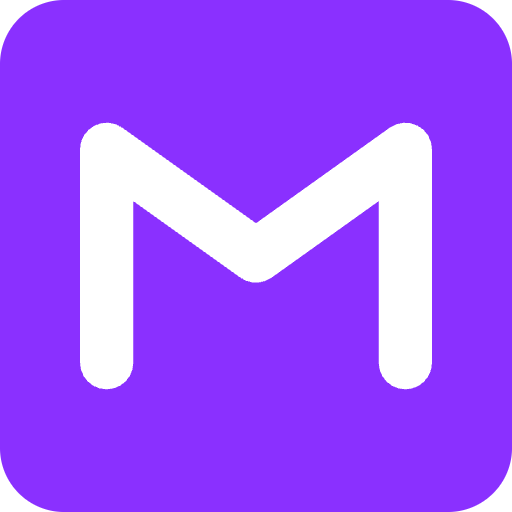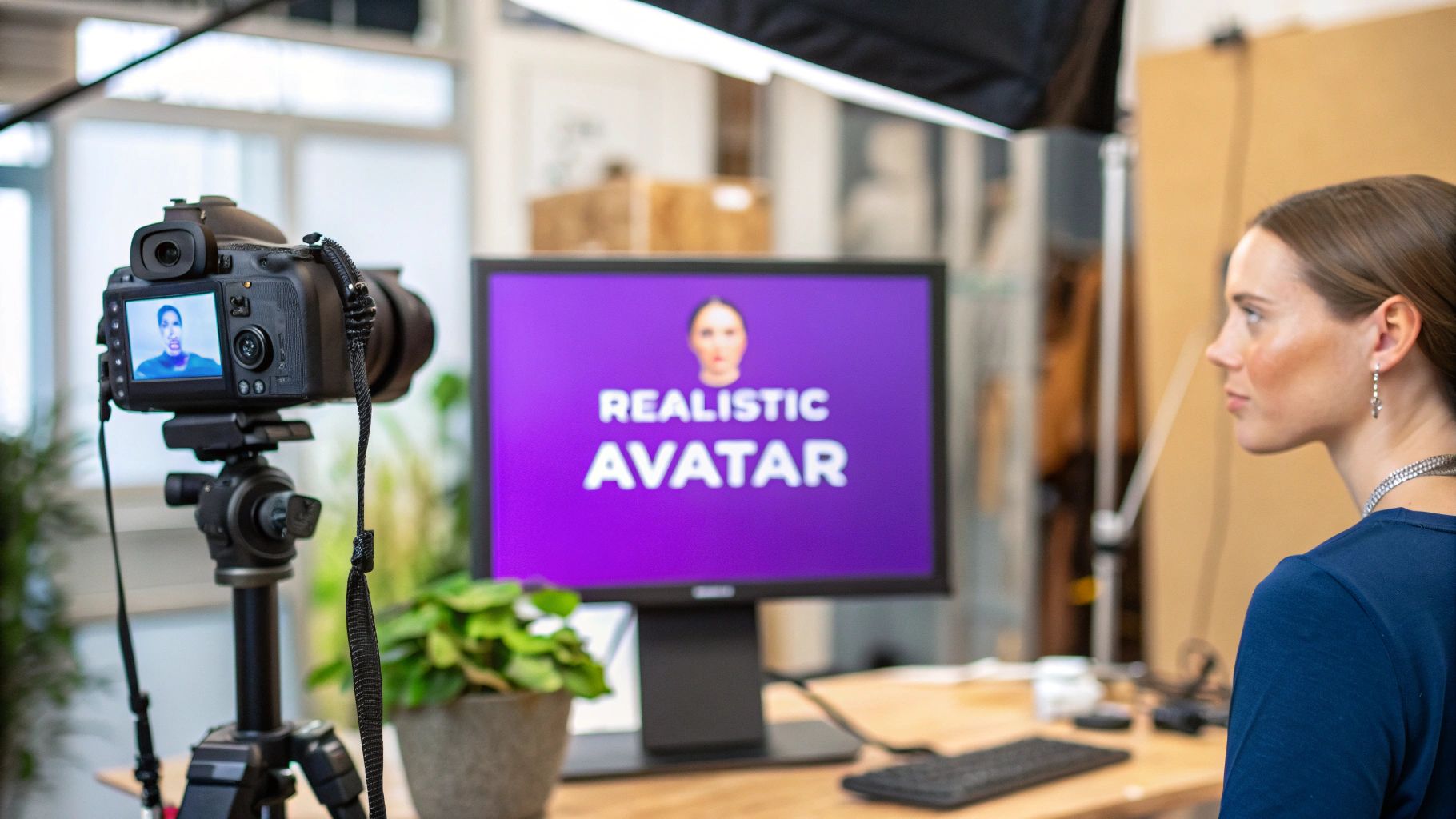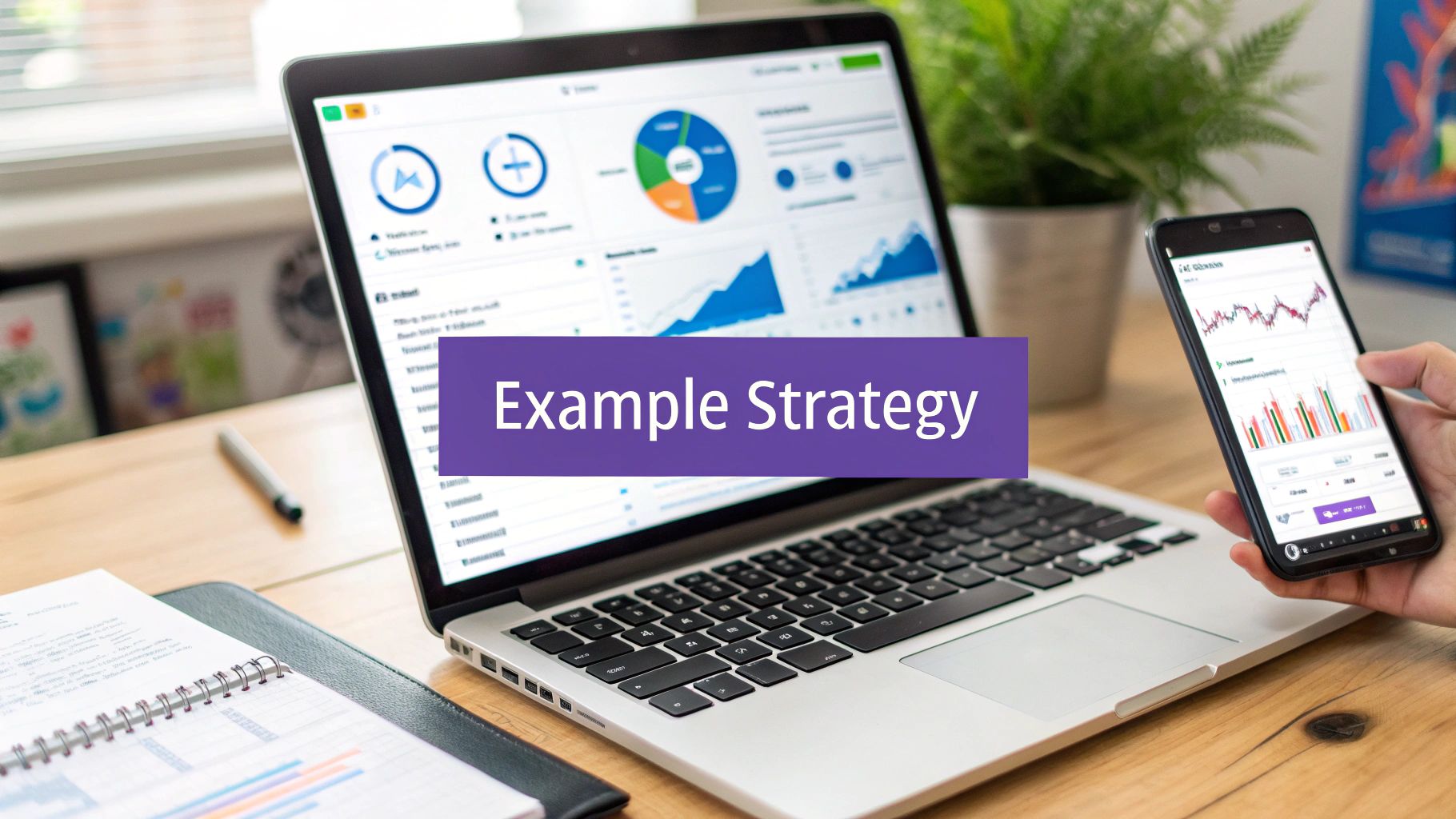9 Proven Social Media Content Ideas for 2025

In the fast-paced world of digital marketing, staring at a blank content calendar can be daunting for any professional, freelancer, or agency. The pressure to consistently create engaging, fresh, and impactful posts is immense. Standard advice often falls flat, leading to generic content that fails to capture attention or drive results. This guide breaks that cycle. We've compiled a powerful list of diverse social media content ideas, moving beyond the obvious to provide actionable strategies that build authority, foster community, and deliver measurable growth.
Each idea is designed for immediate implementation, offering a clear path from concept to execution. You will find specific examples and practical steps tailored for professionals who need to see a return on their content investment. We'll also highlight how innovative AI tools like MakerBox can streamline your ideation process, turning content creation from a chore into a strategic advantage. This isn't just another list of suggestions; it's a blueprint for a more effective social media presence. Get ready to fill your content pipeline with ideas that actually work and resonate with your target audience, from job seekers to startup founders.
1. Behind-the-Scenes Content
One of the most powerful social media content ideas for building authentic connections is sharing a look behind the curtain. Behind-the-scenes (BTS) content demystifies your brand, showing the real people, messy creative processes, and genuine moments that define your work. It trades polished perfection for relatable transparency, which is a highly effective way to build trust and foster a loyal community. This approach humanizes your brand, making it feel more like a group of passionate individuals and less like a faceless corporation.
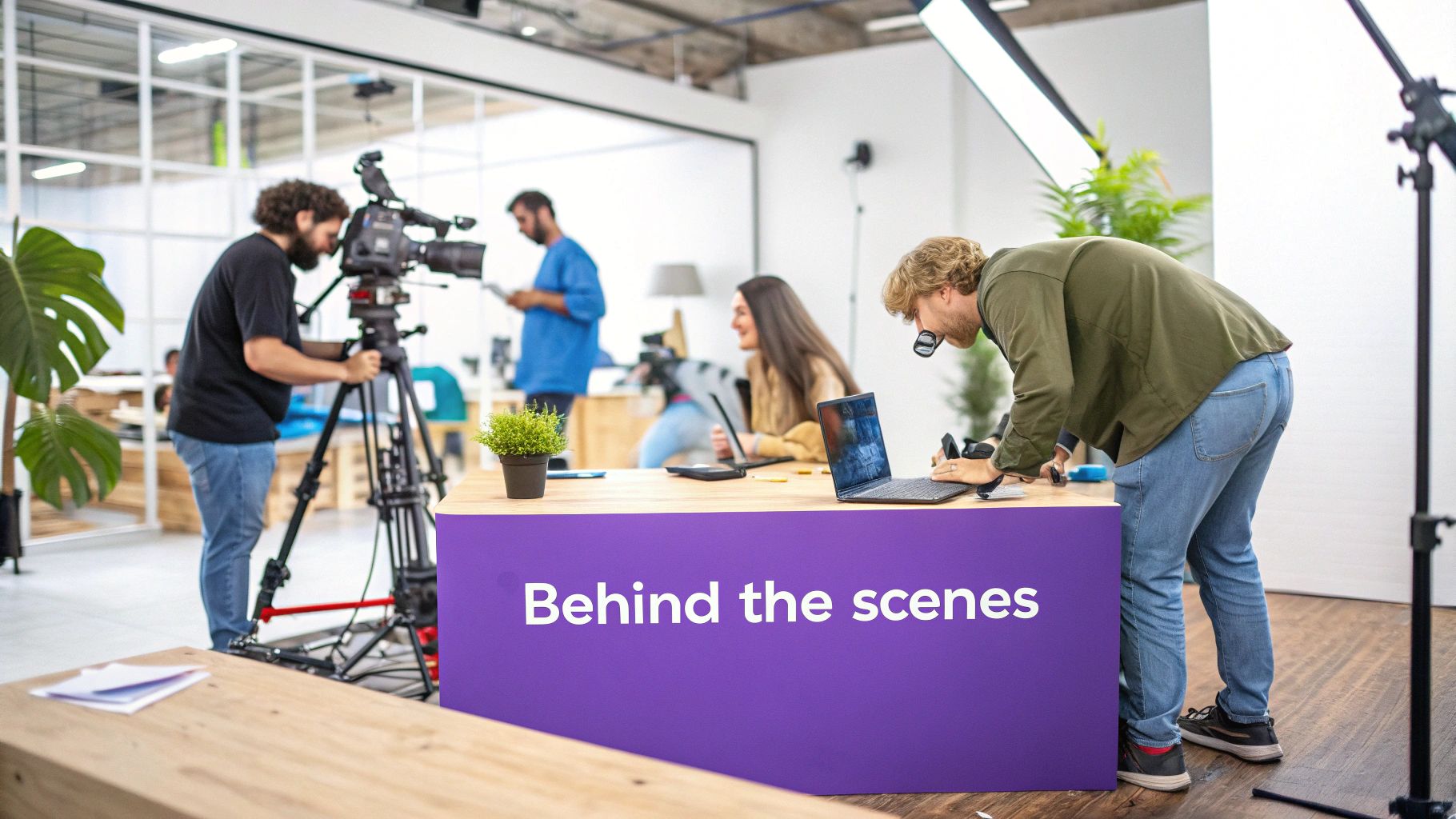
This strategy works because audiences are naturally curious. They want to see the "how" behind the "what." A freelance graphic designer could post a time-lapse video of their logo creation process, a marketing agency could share a candid clip from a team brainstorming session, and a startup founder could record a short video discussing a recent challenge and how they are navigating it.
How to Implement Behind-the-Scenes Content
To make this strategy work, you don’t need a high-end production setup. Authenticity is the goal.
- Document, Don't Create: Get in the mindset of capturing moments as they happen. Keep your phone handy to record spontaneous interactions, a complex problem-solving moment, or the unboxing of new office equipment.
- Show the Process, Not Just the Product: Break down how a project comes to life. Show initial sketches, team members collaborating, or even the "fails" that led to a final success. This narrative is compelling and educational.
- Highlight Your Team: Feature different team members and their roles. A short Instagram Story introducing your project manager or a LinkedIn post celebrating a developer's contribution makes your brand more personal and values your employees.
Key Insight: The magic of BTS content is its imperfection. A slightly shaky camera or unrehearsed dialogue often performs better than a slick, scripted video because it feels real and trustworthy.
2. User-Generated Content (UGC)
Harnessing the power of your audience is one of the most effective social media content ideas for building social proof and fostering a vibrant community. User-generated content (UGC) involves sharing posts, images, or videos created by your customers and followers that feature your brand. This strategy essentially turns your audience into brand advocates, leveraging their authentic experiences to build credibility and trust in a way that polished marketing campaigns often cannot.

This approach works because modern consumers trust recommendations from peers far more than they trust direct advertising. By showcasing real people using and loving your products or services, you validate your brand's value proposition organically. Classic examples include GoPro's breathtaking customer-shot adventure videos, Starbucks' annual #RedCupContest, and Airbnb highlighting stunning stays shared by hosts and guests. These campaigns encourage participation and create a powerful, self-sustaining cycle of promotion.
How to Implement User-Generated Content
A successful UGC strategy is about encouraging and curating content, not just passively waiting for it.
- Create a Branded Hashtag: Launch a simple, memorable hashtag and encourage your audience to use it when they post about you. This makes it easy to find and track submissions.
- Always Ask for Permission: Before reposting any content, reach out to the original creator for their explicit permission. Always give them full credit in your post by tagging their profile and mentioning them in the caption.
- Offer Incentives and Recognition: Motivate participation by running contests, offering discounts, or simply featuring the best submissions prominently on your page. Making your audience feel seen and appreciated is key.
Key Insight: UGC serves as powerful, third-party validation. When a potential customer sees others like them enjoying your brand, it lowers their purchase anxiety and builds immediate, authentic trust.
3. Educational and How-To Content
One of the most valuable social media content ideas is to teach your audience something useful. Educational and how-to content positions your brand as a generous expert by providing actionable information, tutorials, or insights that help followers solve a problem or learn a new skill. Instead of just selling, you are serving. This builds immense trust and establishes your authority, making your audience more likely to turn to you when they are ready to buy.
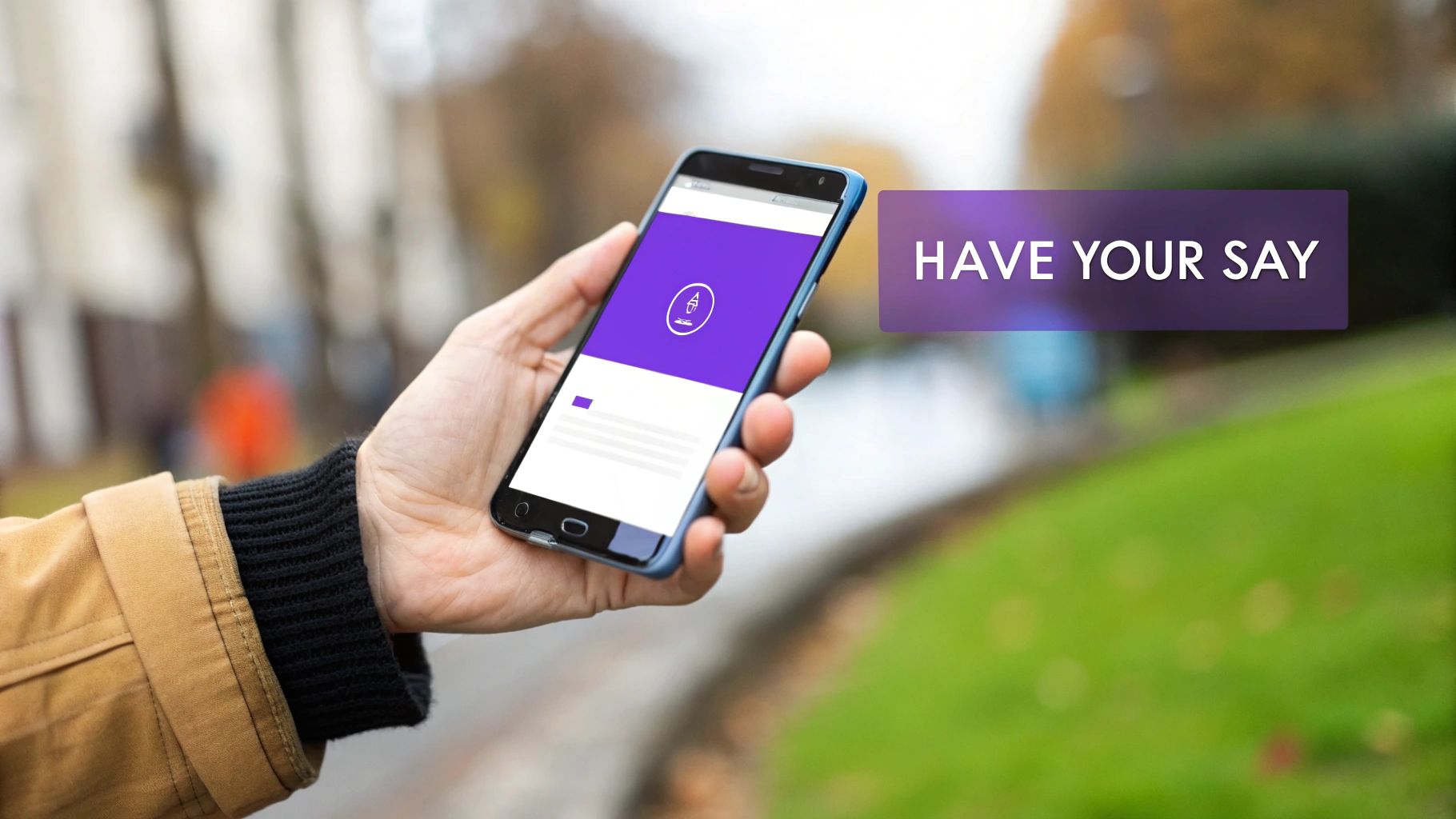
This strategy is effective because it directly addresses your audience's pain points. An SEO consultant can create a short video series explaining how to perform a basic keyword analysis, a productivity software company could publish a carousel post on how to plan your week effectively, and a freelance writer could offer a guide on crafting compelling headlines. By giving away valuable knowledge, you create a loyal following that sees you as an indispensable resource.
How to Implement Educational and How-To Content
Effective educational content is clear, accessible, and focused on providing a tangible outcome for the viewer.
- Solve Real Problems: Start by identifying the most common questions and challenges your target audience faces. Use your expertise to create content that provides a direct solution.
- Break It Down: Deconstruct complex topics into simple, digestible steps. Use numbered lists, short video clips, or carousel slides to walk your audience through the process one piece at a time.
- Use Clear Visuals: Show, don't just tell. Use screen recordings for software tutorials, diagrams for complex concepts, and high-quality videos or photos for physical demonstrations. Visual aids make learning easier and more engaging.
Key Insight: Your goal isn't to give away all your secrets but to empower your audience with a small, meaningful win. A taste of success will leave them wanting more of your expertise.
4. Interactive Polls and Q&A Sessions
One of the most direct social media content ideas to boost engagement is to simply ask your audience to participate. Interactive content like polls, quizzes, and Q&A sessions transforms passive scrolling into active participation. This creates a two-way dialogue, making your followers feel seen and valued while providing you with invaluable, real-time feedback on their preferences, pain points, and interests. This strategy is essential for building a community, not just an audience.

This method thrives because people love sharing their opinions and testing their knowledge. A marketing agency could run a LinkedIn poll asking which emerging trend will have the biggest impact, a freelancer could use an Instagram Stories quiz to see how much their audience knows about their niche, and a startup founder could host a live Q&A session on X (formerly Twitter) to address user questions directly after a new feature launch.
How to Implement Interactive Polls and Q&A Sessions
The key is to make participation easy and rewarding. Most platforms have built-in features that handle the heavy lifting.
- Ask Relevant, Specific Questions: Move beyond generic questions like "How is your day?" Instead, ask something that ties directly to your expertise or industry. For example, a web developer could ask, "Which Javascript framework are you most excited about for 2024?"
- Schedule and Promote Q&As: Don't just go live unexpectedly. Announce your Q&A session in advance to build anticipation and allow followers to prepare questions. Post reminders in the hours leading up to the event.
- Create Follow-Up Content from Results: The interaction shouldn't end when the poll closes. Share the results in a new post, discuss surprising outcomes, and explain what the data means for your brand or industry. This closes the loop and shows you value the input.
Key Insight: Interactive content is a powerful market research tool disguised as a fun engagement tactic. The answers you receive can directly inform your content strategy, product development, and service offerings.
5. Trending Topics and Newsjacking
One of the most agile social media content ideas is newsjacking, which involves strategically inserting your brand into a trending news story or viral conversation. This tactic leverages existing audience attention and momentum, placing your brand directly into the discussions people are already having. When executed thoughtfully, newsjacking can dramatically boost your visibility and portray your brand as timely, relevant, and culturally aware. It's a powerful way to tap into a massive, pre-engaged audience without having to build interest from scratch.
This strategy works because it capitalizes on the fear of missing out (FOMO) and the public's desire to engage with what's current. A classic example is Oreo's "You can still dunk in the dark" tweet during the 2013 Super Bowl blackout. More recently, a project management software company could create content around a major tech conference, sharing its take on the key announcements. A freelance copywriter could write a thread on a viral marketing campaign, breaking down why its messaging was so effective.
How to Implement Trending Topics and Newsjacking
Success requires speed, relevance, and a strong sense of your brand's voice. Authenticity is crucial to avoid appearing opportunistic.
- Monitor Trends Actively: Use social listening tools like SparkToro or even the built-in "Explore" pages on platforms like X (formerly Twitter) and Instagram. Set up alerts for keywords relevant to your industry so you can be among the first to react.
- Act Quickly but Thoughtfully: The window for a trend is often short. Have a streamlined approval process in place to move fast. Before posting, ask: Is this relevant to my brand? Does it add value to the conversation? Could this be misinterpreted negatively?
- Add a Unique Angle: Don’t just report the news; provide your unique perspective. Connect the trend back to your industry, your services, or your brand’s core values. This is what separates genuine contribution from simple bandwagoning.
Key Insight: The best newsjacking doesn't feel like an advertisement. It feels like a clever, insightful, or humorous contribution to a global conversation from a brand that "gets it."
6. Storytelling and Personal Narratives
Facts tell, but stories sell. Harnessing the power of storytelling is one of the most timeless and effective social media content ideas available. This strategy involves weaving narratives around your experiences, values, or mission to create a powerful emotional connection with your audience. Personal narratives make abstract concepts tangible and transform a faceless brand into a relatable entity with a compelling journey. It’s about sharing triumphs, struggles, and key lessons in a way that resonates on a human level.
This method moves beyond direct promotion to build deep-seated loyalty. A startup founder can share the story of the near-failure that led to their biggest breakthrough, a freelancer can recount how a difficult client taught them a valuable lesson about setting boundaries, and an agency can tell the story of a campaign that made a real-world impact. These narratives are memorable, shareable, and build brand affinity far more effectively than a simple sales pitch.
How to Implement Storytelling and Personal Narratives
Effective storytelling feels authentic and delivers a clear message. Vulnerability is a strength here, but it should always be purposeful.
- Structure Your Narrative: A good story has a clear beginning (the setup), middle (the conflict or challenge), and end (the resolution or lesson learned). Use this simple framework to guide your posts, whether it's a short text update or a multi-part video series.
- Focus on Universal Themes: Connect your personal experience to universal emotions like hope, perseverance, or belonging. This makes your story relatable even to an audience with different backgrounds.
- Be Vulnerable, Not Vague: Don't just say you faced a challenge; describe it. Use vivid details to paint a picture and allow your audience to feel the emotional weight of the journey. The goal is to be open and authentic while maintaining professional boundaries.
Key Insight: The most powerful stories aren't about being perfect; they are about being human. Sharing a lesson learned from a mistake often builds more trust and credibility than only highlighting your successes.
7. Memes and Viral Content
Leveraging memes and viral trends is one of the most effective social media content ideas for demonstrating cultural relevance and connecting with audiences through humor. This strategy involves tapping into existing internet trends, popular culture references, and recognizable meme formats to create content that is highly shareable and relatable. When done right, it makes your brand feel less like a corporation and more like an active, savvy participant in online culture.
This approach works because memes are a shared language. They create an instant connection built on a common joke or cultural touchstone. Brands like Wendy's, with its roast-style Twitter presence, and Duolingo, with its unhinged TikTok persona, have mastered this by embedding their brand voice directly into viral formats. A marketing agency could use a trending reaction GIF to comment on a common client request, or a freelancer could use a popular meme template to humorously depict the feast-or-famine cycle of project work.
How to Implement Memes and Viral Content
Success with memes requires a blend of speed, awareness, and brand alignment. You can’t just post any trending image; it has to make sense for your audience.
- Stay Current and Relevant: Memes have a short lifespan. Use platforms like TikTok, X (formerly Twitter), and Reddit to monitor emerging trends. Act quickly, but ensure the trend is still relevant when you post.
- Align with Your Brand Voice: Don’t force humor where it doesn’t belong. The meme should feel like a natural extension of your brand's personality. If your brand is serious and authoritative, this strategy may not be the right fit.
- Add Your Own Spin: The best meme marketing doesn’t just copy a format; it adapts it to a specific niche. Connect the trend to a pain point or inside joke that is unique to your industry or audience for maximum impact.
Key Insight: The goal isn't just to be funny; it's to be relatable. A well-executed meme shows your audience that you "get it" and understand their world, which builds a surprisingly strong sense of community and brand loyalty.
8. Live Streaming and Real-Time Content
Harnessing the power of live video is one of the most dynamic social media content ideas for fostering direct, unscripted engagement. Live streaming involves broadcasting real-time video to your audience, creating an immediate and interactive channel for communication. This format's ephemeral nature builds a sense of urgency and exclusivity, encouraging viewers to tune in and participate at that moment. It transforms passive content consumption into an active, shared experience.
This strategy excels because it offers unparalleled authenticity and immediacy. A marketing agency could host a LinkedIn Live session with a panel of experts discussing industry trends, a freelance coach could run an impromptu Q&A on Instagram Live to address common client pain points, or a startup could launch a new feature with a live demo on YouTube. The real-time feedback loop allows you to answer questions, acknowledge comments by name, and adapt your content on the fly, making your audience feel seen and valued.
How to Implement Live Streaming and Real-Time Content
Successful live streams feel spontaneous but are backed by solid preparation.
- Promote in Advance: Build anticipation for your live event. Announce it on your social channels, in your newsletter, and through Stories a few days beforehand. Use countdown timers to remind your audience.
- Prepare an Outline, Not a Script: Have a clear plan with key talking points, questions to ask, or a sequence of events. This structure keeps you on track while allowing for the flexibility to interact with the audience and go off-piste when a great conversation starts.
- Engage Actively with the Audience: The core value of "live" is interaction. Acknowledge viewers as they join, read comments aloud, answer questions as they come in, and thank people for their participation. Make it a two-way conversation.
Key Insight: Don't let the fear of imperfection stop you. Minor technical glitches or fumbled words are part of the live experience and often make you more relatable. Your audience values the direct access to you more than a flawless production.
9. Seasonal and Holiday Content
Tapping into the spirit of a season or holiday is one of the most reliable social media content ideas for driving timely engagement. Seasonal content aligns your brand with annual events, cultural celebrations, and holidays, allowing you to join conversations that are already top-of-mind for your audience. This strategy makes your content feel instantly relevant and relatable, capitalizing on the shared emotions and traditions of a specific time of year. It’s a chance to show your brand's personality and connect on a more human level.
This approach is effective because it leverages existing excitement and anticipation. Think of Starbucks’ mastery of autumn with its Pumpkin Spice Latte launch or REI’s counter-cultural #OptOutside campaign for Black Friday. A B2B software company could create a "spring cleaning" guide for digital workflows, while a freelance writer might offer a "back-to-school" discount on blog post packages in late summer. The key is to connect the seasonal theme back to your unique value proposition.
How to Implement Seasonal and Holiday Content
Success with this strategy comes from planning and creativity, not just posting a simple "Happy Holidays" graphic.
- Plan a Content Calendar: Map out major and minor holidays, seasons, and relevant awareness days months in advance. This prevents last-minute scrambling and allows for more thoughtful campaign development.
- Add a Unique Brand Twist: Avoid generic holiday greetings. Tie the event to your brand’s mission or products. For example, a productivity app could share tips on "staying focused during the holiday rush."
- Explore Niche Holidays: Stand out from the noise of major holidays by celebrating lesser-known ones that align with your brand. A design agency could create a cool graphic for World Creativity Day, or a coffee brand could celebrate National Espresso Day.
Key Insight: The best seasonal content feels authentic to the brand, not forced. Connect the holiday to your core values or offer genuine value related to the theme, rather than just using it as a sales opportunity.
Social Media Content Ideas Comparison
| Content Type | Implementation Complexity 🔄 | Resource Requirements 💡 | Expected Outcomes 📊 | Ideal Use Cases 💡 | Key Advantages ⭐⚡ |
|---|---|---|---|---|---|
| Behind-the-Scenes Content | Medium - requires strategic planning and consistency | Low to Medium - mostly mobile or simple setup | Builds trust and high engagement | Brand humanization, culture showcasing, authentic connection | Authenticity, cost-effective, increases relatability |
| User-Generated Content (UGC) | Low to Medium - requires moderation and incentives | Low - relies on users to create content | Strong community engagement and social proof | Community building, social proof, expanding reach | Authentic testimonials, cost-effective, expands reach |
| Educational and How-To Content | Medium to High - requires deep knowledge and creation | Medium to High - research, scripting, production | Establishes authority, improves SEO, lasting value | Teaching, problem-solving, thought leadership | Builds expertise, encourages shares, multi-format reuse |
| Interactive Polls & Q&A | Low - easy to create but needs active monitoring | Low - minimal production, requires live attention | Boosts engagement, provides insights | Audience feedback, community building, real-time interaction | High engagement, audience insights, quick to deploy |
| Trending Topics & Newsjacking | High - needs fast turnaround and cultural sensitivity | Low to Medium - rapid content creation and approval | Viral reach, brand relevance | Capitalizing on trends, cultural relevance, timely marketing | Massive exposure, cultural awareness, cost-effective |
| Storytelling & Personal Narratives | Medium to High - crafting compelling stories takes time | Medium - scripting, visuals, editing | Emotional connections, memorability | Brand relatability, emotional engagement, long-form content | Builds trust, memorable, encourages engagement |
| Memes and Viral Content | Low to Medium - fast-paced but needs cultural insight | Low - minimal production | High viral potential | Humor-driven engagement, youth targeting, trend exploitation | High shareability, cost-effective, relatable |
| Live Streaming & Real-Time | Medium to High - requires comfort with unscripted, technical setup | Medium - tech setup, moderation | High engagement and authenticity | Product launches, Q&As, events, real-time communication | Urgency, interactivity, authentic connections |
| Seasonal and Holiday Content | Low to Medium - planned and repetitive | Low to Medium - thematic production | Timely relevance and emotional connection | Holiday promotions, seasonal campaigns, cultural participation | Predictable planning, emotional resonance, promotion |
From Ideas to Impact: Your Content Creation Engine
Navigating the dynamic world of social media requires more than just a sporadic post; it demands a strategic, diverse, and consistent content plan. Throughout this guide, we've explored a powerful arsenal of nine distinct social media content ideas, moving from the authentic appeal of behind-the-scenes glimpses to the timely relevance of newsjacking and the engaging power of interactive polls. Each strategy represents a unique opportunity to connect with your audience on a deeper level, build authority, and drive meaningful results.
The true takeaway isn't just about having this list. It's about understanding that a successful social media presence is a tapestry woven from different threads. Your most effective content calendar will blend educational how-to guides with personal storytelling, and lighthearted memes with insightful live Q&A sessions. This variety keeps your feed fresh, caters to different audience preferences, and showcases the multifaceted nature of your brand or professional identity.
Activating Your Content Strategy
The journey from a great idea to a high-performing post can often feel daunting. This is where a systematic approach becomes your greatest asset. To transform this list of social media content ideas into a sustainable engine for growth, focus on these critical next steps:
- Create a Content Mix: Don't rely on a single format. Plan your upcoming weeks by intentionally scheduling different types of content. For example, dedicate Mondays to educational posts, Wednesdays to behind-the-scenes stories, and Fridays to interactive polls or user-generated content features.
- Establish a Workflow: Consistency trumps intensity. The key to avoiding burnout and maintaining momentum is to build a repeatable process. This includes batching content creation, scheduling posts in advance, and setting aside specific times for community engagement.
- Analyze and Adapt: Your audience's engagement is the ultimate feedback loop. Regularly review your analytics to see which content formats generate the most comments, shares, and clicks. Use these insights to refine your strategy, doubling down on what works and experimenting with new approaches for what doesn’t.
Ultimately, mastering your social media is about building a system that bridges the gap between inspiration and execution. The value lies not just in attracting followers, but in building a community, generating leads, and establishing yourself as a go-to expert in your field. By combining the versatile strategies we've covered with a commitment to consistent implementation, you can turn your social media channels from a daily chore into a powerful asset that fuels your professional or business growth.
Ready to stop brainstorming and start creating? MakerBox provides an AI-powered content library and scheduling tools designed to bring these social media content ideas to life in minutes. Sign up for MakerBox today to build your content engine and accelerate your social media growth.
